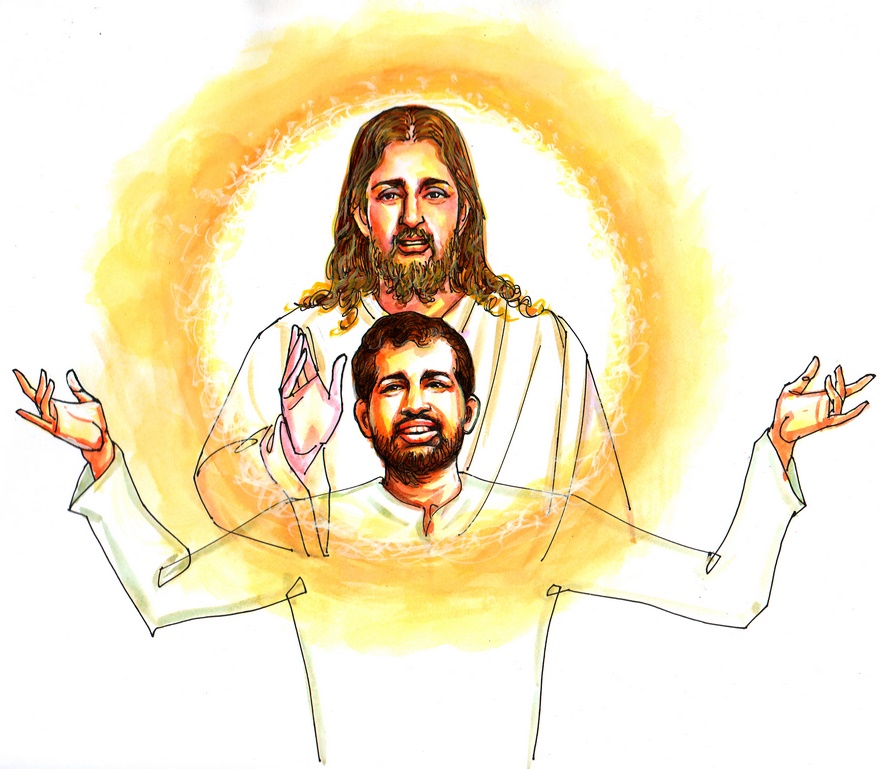The central argument of the RK Mission for its non-Hindu character was that, unlike Hinduism, it upheld the ‘equal truth of all religions’ and the ‘equal respect for all religions’. The latter slogan was popularized by Mahatma Gandhi as sarva-dharma-samabhâva, a formula officially approved and upheld in the BJP’s constitution. In 1983, RK Mission spokesman Swami Lokeshwarananda said: ‘Is Ramakrishna only a Hindu? Why did he then worship in the Christian and Islamic fashions? He is, in fact, an avatar of all religions, a synthesis of all faiths.
The basis of the Swami’s claim is a story that Swami Vivekananda’s guru Paramahansa Ramakrishna (1836-86) once, in 1866, dressed up as a Muslim and then continued his spiritual exercises until he had a vision; and likewise as a Christian in 1874. If at all true, these little experiments shouldn’t be given too much weight, considering Ramakrishna’s general habit of dressing up a little for devotional purposes, e.g. as a woman, to experience Krishna the lover through the eyes of His beloved Radha (not uncommon among Krishna devotees in Vrindavan); or hanging in trees to impersonate Hanuman, Rama’s monkey helper.
[wp_ad_camp_1]
But is the story true? Author Ram Swarup finds that it is absent in the earliest recordings of Ramakrishna’s own talks. It first appears in a biography written 25 years after Ramakrishna’s death by Swami Saradananda (Sri Ramakrishna, the Great Master), who had known the Master only in the last two years of his life. Even then, mention (on just one page in a 1050-page volume) is only made of a vision of a luminous figure. The next biographer, Swami Nikhilananda, ventures to guess that the figure was ‘perhaps Mohammed’. In subsequent versions, this guess became a dead certainty, and that ‘vision of Mohammed’ became the basis of the doctrine that he spent some time as a Muslim, and likewise as a Christian, and that he ‘proved the truth’ of those religions by attaining the highest yogic state on those occasions.7
It is hard not to sympathize with Ram Swarup’s skepticism. In today’s cult scene there are enough wild claims abroad, and it is only right to hold their propagators guilty (of gullibility if not of deception) until proven innocent. In particular, a group claiming ‘experimental verification of a religious truth claim as the unique achievement of its founder should not be let off without producing that verification here and now; shady claims about an insufficiently attested event more than a century ago will not do. It is entirely typical of the psychology behind this myth-making that a researcher can testify: Neither Swami Vivekananda, nor any other monk known to the author, ever carried out his own experiments. They all accepted the truth of all religions on the basis of their master’s work. This is the familiar pattern of the followers of a master who are too mediocre to try for themselves that which they consider as the basis of the master’s greatness, but who do not hesitate to make claims of superiority for their sect on that same (untested, hearsay) basis.
For some more polemical comment, let us look into one typical pamphlet by a Hindu upholding the Hindu character of the Ramakrishna Mission: The Lullaby of ‘Sarva-Dharma-Samabhâva’ (‘equal respect for all religions’) by Siva Prasad Ray. The doctrine of ‘equal respect for all religions’ (in fact, even a more radical version, ‘equal truth of all religions’, is one of the items claimed by the RK Mission as setting it apart from Hinduism.
This doctrine is propagated by many English-speaking gurus, and one of its practical effects is that Hindu girls in westernized circles (including those in overseas Hindu communities) who fall in love with Muslims, feel justified in disobeying their unpleasantly surprised parents, and often taunt them: ‘What is the matter if I marry a Muslim and your grandchildren become Muslims? Don’t these Babas to whom you give your devotion and money always say that all religions teach the same thing, that Islam is as good as Hinduism, that Allah and Shiva are one and the same?‘
When such marriages last (many end in early divorce), a Hindu or Western environment often leads to the ineffectiveness of the formal conversion of the Hindu partner to Islam, so that the children are not raised as Muslims. Yet, Islamic law imposes on the Muslim partner the duty to see to this, and in a Muslim environment there is no escape from this islamizing pressure. Thus, after the Meenakshipuram mass conversion to Islam in 1981, non-converted villagers reported: ‘Of course, there have been marriages between Hindu harijans and the converts. Whether it is the bride or the groom, the Hindu is expected to convert to Islam.‘
Even when the conversion is an ineffective formality, such marriages or elopements which trumpet the message that Hindu identity is unimportant and dispensible, do have an unnerving effect on vulnerable Hindu communities in non-Hindu environments. They also remain an irritant to Hindus in India, as here to writer Siva Prasad Ray. More generally, the doctrine that all religions are the same leaves Hindus intellectually defenceless before the challenge of communities with more determination to uphold and propagate their religions.
To counter the facile conclusion that Ramakrishna had practised Christianity and Islam and proven their truth, Siva Prasad Ray points out that Ramakrishna was neither baptized nor circumcised, that he is not known to have affirmed the Christian or Islamic creed, etc. Likewise, he failed to observe Ramzan or Lent, he never took Christian or Islamic marriage vows with his wife, he never frequented churches or mosques. This objection is entirely valid: thinking about Christ or reading some Islamic book is not enough to be a Christian or a Muslim.
Equally to the point, he argues: ‘Avatar’ or incarnation may be acceptable to Hinduism but such is not the case with Islam or Christianity. In Christianity, one might say that the notion of divine incarnation does exist, but it applies exclusively to Jesus Christ; applying it to Ramakrishna is plain heresy. Sitting down for mental concentration to obtain a ‘vision’ of Christ or Mohammed is definitely not a part of the required practices of Christianity or Islam. Neither religion has a notion of ‘salvation’ as something to be achieved by practising certain states of consciousness. In other words: before you claim to have an agreement with other people, check with them whether they really agree.
The same objection is valid against claims that Swami Vivekananda was ‘also’ a Muslim, as Kundrakudi Adigalar, the 45th head of the Kundrakudi Tiruvannamalai Adhinam in Tamil Nadu, has said: He had faith and confidence in Hinduism. But he was not a follower of Hinduism alone. He practised all religions. He read all books. His head bowed before all prophets. But ‘practising all religions’ is quite incompatible with being a faithful Christian or Muslim: as the Church Fathers taught, syncretism is typical of Pagan culture (today, it is called ‘New Age’). Leaving aside polytheistic Hinduism, the mere attempt to practise both Islam and Christianity, if such a thing were possible, would have stamped Ramakrishna as definitely not a Christian nor a Muslim.
Moreover, it is simply untrue that Swami Vivekananda ever ‘practised’ Christianity or Islam: he was not baptized or circumcised, did not attend Church services or Friday prayers, never went to Mecca, never observed Ramzan or Lent. But he did practise vegetarianism (at least in principle) and celibacy, which are both frowned upon in Islam. Worst of all, he did worship Hindu Gods, which by definition puts him outside the Islamic fold, Islam being based on the rejection of all Gods except Allah.
Ramakrishna was quite satisfied worshipping Goddess Kali, but: ‘There is no respectful place for deities in female form in Islam. Rama Krishna engaged in the worship of Kali was nothing but an idolater in the eyes of the Muslims. Islam says that all idolaters will finally end up in Islam’s hell. Now, I want to ask these egg-heads of sarva-dharma-samabhâva if they know where exactly is the place for Rama Krishna in Islam? The fact is that Rama Krishna never truly worshipped in the Islamic fashion, neither did he receive Islamic salvation.
Ray challenges the RK Mission monks to try out their assertions on a Muslim or Christian audience: ‘All this is, thus, nothing but creations of confused and boisterous Hindu monks. No Christian padre or Muslim maulvi accepts Rama Krishna’s salvation in their own religions. They make snide remarks. They laugh at the ignorance of the Hindu monks.Ray makes the snide insinuation explicit: ‘Only those Hindus who do not understand the implications of other religions engage themselves in the propagation of sarva-dharma-samabhâva; like stupid and mentally retarded creatures, such Hindus revel in the pleasures of auto-erotism in their wicked pursuit of the fad. This rude comparison means that they pretend to be interacting with others, but it is a mere fantasy, all inside their own heads, with the assumed partners not even knowing about it.
Finally, Ray wonders what happened to the monks, those of the RK Mission and others, who talked about ‘equal truth of all religions’ and chanted ‘Râm Rahîm ek hai’ (‘Rama and Rahim/Allah are one’) and ‘Ishwar Allâh tere nâm’ (‘both Ishwara and Allah are Your names’) in East Bengal before 1947. As far as he knows, they all fled across the new border when they suddenly found themselves inside Pakistan, but then: ‘Many a guru from East Bengal [who] has been saved by the skin of his teeth, once in West Bengal, resumed his talk of sarva-dharma-samabâva. But the point still remains that if they really had faith in the message of sarva-dharma-samabhâva, they would not have left East Bengal. As so often in Indo-Pakistani and Hindu-Muslim comparisons, the argument is reminiscent of the inequality between the contenders in the Cold War: you could demonstrate for disarmament in the West, but to demonstrate for this in the East Bloc (except if it were for unilateral disarmament by the Western ‘war-mongers’ would have put you in trouble.
Siva Prasad Ray also mocks the RK Mission’s grandiose claim of having evaluated not just a few popular religions, but all religions: ‘Did Rama Krishna ever worship in accordance with Sikh, Buddhist, Jain, Saurya or Ganapatya principles? No, he did not. Neither did he worship in accordance with the Jewish faith of Palestine, the Tao religion of China, the religion of Confucius, or the Shinto religion of Japan. Empirically verifying the truth of each and every religion is a valid project in principle, but a very time-consuming one as well.
According to Ray, the slogan of ‘equal truth of all religions’ is nothing but a watered-down sentiment that means nothing. It is useful only in widening the route to our self-destruction. It does not take a genius to realise that not all paths are good paths in this life of ours; this is true in all branches of human activity. Unlike the RK Mission monks, Ray has really found some common ground with other religions and with rationalism too: they all agree on the logical principle that contradictory truth claims cannot possibly all be right; at most one of them can be right.
To sum up, Ray alleges that the RK Mission stoops to a shameful level of self-deception and ridicule, that it distorts the message of Ramakrishna the Kali-worshipping Hindu, and that it distorts the heritage of Swami Vivekananda the Hindu revivalist. Yet, none of this alleged injustice to Hinduism gives the Mission a place outside Hinduism. After all, there is no definition of ‘Hindu’ which precludes Hindus from being mistaken, self-deluding or suicidal. Regardless of its fanciful innovations, the RK Mission remains a Hindu organization, at least by any of the available objective definitions. Alternatively, if the subjective definition, ‘Is Hindu, he and only he who calls himself ‘Hindu’, is accepted, then of course the RK Mission, unlike its founders, is no longer Hindu,-but then it is no longer Ramakrishna’s mission either.
The larger issue revealed by the incident with the RK Mission is a psychology of self-repudiation which is fairly widespread in the anglicized segment of Hindu society, stretching from actual repudiation of Hinduism to the distortive reformulation of Hinduism itself after the model of better-reputed religions. In a typical symptom of the colonial psychology, many Hindus see themselves through the eyes of their once-dominant enemies, so that catechism-type books on Hinduism explain Hinduism in Christian terms, e.g. by presenting many a Hindu saint as ‘a Christ-like figure’ modern translations of Hindu scriptures are often distorted in order to satisfy non-Hindu requirements such as monotheism. This can take quite gross forms in the Veda translations of the Arya Samaj, where entire sentences are inserted in order to twist the meaning in the required theological direction. The eagerness to extol all rival religions and to be unsatisfied with just being Hindu is one more symptom of the contempt in which Hinduism has been held for centuries, and which numerous Hindus have interiorized.
‘various creeds you hear about nowadays have come into existence through the will of God and will disappear again through His will ‘Hindu religion’ alone is Sanâtana dharma’ for it ‘has always existed and will always exist’ …Ramakrishna
Source: koenraadelst.blogspot.in















Great to see Koenraad Elst’s article on Indiadivine. Please publish his original research articles also…
While reconciling sanatana dharma with mainstream Christianity or Islam is impossible there are esoteric versions of these two creeds that may be compatible with Indic faiths. There have been many creative interactions of this kind since the meeting of Mediterranean faiths with dharma. Perhaps a research project on this could be launched looking for intersections between these subaltern traditions and dharma. I agree with the author that such a project would be of no interest to mainstream Christianity or Islam but the value of the project would be seeing the reflection of dharma in these other faiths once they are suitably polished, establishing the universality of dharmic truths for those who seek such validation.
Why don’t we understand that how much ever Hindus say we pray to jesus/allah, the opposite can never be true.
Only a hindu can even do what Ramakrishna did (if he ever did “follow” islam/christianity).
Paramahansa Yogananda had the following experience of Christ:
“My singular desire to discern rightly the true meaning of Christ’s words was given wondrous confirmation one night during a period when I was working on these interpretations. It was in the Hermitage at Encinitas, California. I was sitting in my darkened room in meditation, praying deeply from my soul, when suddenly the blackness gave way to a celestial opal-blue effulgence. The entire room was like an opal flame. In that light the radiant form of the blessed Lord Jesus appeared.
His face was divine. His appearance was of a young man in his twenties, with sparse beard and moustache; his long black hair, parted in the middle, had a golden light about it. His feet were not touching the floor. His eyes were the most beautiful, the most loving eyes I have ever seen. The whole universe I saw glistening in those eyes. They were infinitely changing, and with each transition of expression I intuitively understood the wisdom conveyed. In his glorious eyes I felt the power that upholds and commands the myriad worlds.
As he gazed down at me, a Holy Grail appeared at his mouth. It descended to my lips and touched them; then went up again to Jesus. After a few moments of rapt silent communion, he said to me: “Thou dost drink of the same cup of which I drink.”
At that I bowed down. I was joyous beyond dreams to receive the testimony of his blessings, of his presence. Exactly the words that he said to me in this vision he also said to Thomas, which I never read before.{1} His words meant that I was drinking of his wisdom through the Holy Grail of his perceptions which he has dropped in my consciousness, and he was pleased. He approved very dearly and blessed me for writing these interpretations. This I can say without pride, because the interpretation of Christ’s words herein is not mine. It has been given to me. I am happy this book is coming through me; but I am not the author. It is Christ. I am only the vehicle through which it is explained.”
The experience is the same. Yogananda also had a vision of Christ and Krishna with their disciples:
Years ago, when I was living and teaching in Boston, I once became so busy that I forgot God for three days. The thought of continuing like that was intolerable; I was preparing to pack up everything and leave America. But just then a student of this path came by and asked to meditate with me. As we sat there in meditation I began to pray: “Lord, I love Your work here in America, but I love You more than the work, and if I am going to forget You in this country I will leave.” Inwardly I heard the voice of God: “What do you want?”
Impulsively I said, “I would like to see Krishna and Christ with all their disciples.” Instantly I beheld them, on a sea of gold, just as clearly as I am seeing you; and I worshiped them.
But in a little while my mind began to doubt. “This is not real,” I thought. So I prayed again: “Lord, if the vision is true, let the other devotee in this room also see it.” My friend suddenly cried out, “Oh! Krishna and Christ, on a sea of gold!”
Then a new doubt arose: was it only thought transference? But even as this idea crossed my mind, the voice of God said: “When I leave, the room will become filled with the fragrance of the lotus, and whoever comes shall notice it.” Each person who later visited me in that room unfailingly asked, “What is this strange fragrance of flowers that I smell?”
I see the points that op has made, they seem quite valid, especially the conversion of hindu girls one. I would like to add a perspective
First of all I would like to address why islam sadhana only appeared in Biography by Swami Saradananda. Uptil The Great Master (biography by said swami), the only source of Sri Ramakrishna’s teachings had been Kathamrita (Gospel of Sri Ramakrishna in english) written by his householder disciple Master Mahasay, it is a reliable source and provides deep insight into the teachings and life of saints but there is one shortcoming, Sri Ramakrishna had two category of disciples, householders and monastic, householders used to visit him on weekends while monastic disciples used to visit him on Tuesdays, attributing to this it is very plausible that Master Mahasaya missed Sri Ramakrishna’s some teachings that he only shared with Monastic disciples and these teachings were revealed only when The Great Master was published.
Now coming to the conversion issue, I find the issue very genuine, but I don’t think the solution lies in denying the validity of those faiths, Sri Ramakrishna, even though did not officially converted to these faiths, very much followed the esoteric core of these religions, showing that they too are true. Now does this mean we should abandon hinduism and follow these religions?? not at all!! if that were the case, why would Sri Ramakrishna had remained a hindu? let me tell you the solution, in Swami Vivekananda’s words
“The Christian is not to become a Hindu or a Buddhist, nor is a Hindu or a Buddhist to become a Christian. But each must assimilate the spirit of the others and yet preserve his individuality and grow according to his own law of growth. If the Parliament of Religions has shown anything to the world, it is this: It has proved to the world that holiness, purity, and charity are not the exclusive possessions of any church in the world, and that every system has produced men and women of the most exalted character. In the face of this evidence, if anybody dreams of the exclusive survival of his own religion at the expense of the others, I pity him from the bottom of my heart and point out to him that upon the banner of every religion will soon be written, in spite of resistance: “Help and not Fight,” “Assimilation and not Destruction,” “Harmony and Peace and not Dissension”.”
I think that drives my point home, we are not deny the validity of these faiths, we are to respect them but at the same time take pride in our heritage and protect it.
Antonio Beraldo
Forgive me but I feel that yes, all religions seek God/Brahman/Allah, the Self.
A “superior spirit”, which has already transcended ego barriers, knows that there is only Love. And it is this love that permeates all beliefs and religions around the globe. Yes, Ramakrishna may have transcended worldly barriers and reached the pinnacle of faith in different religious beliefs.